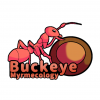Hmm. I find their larval stage is actually very fast.
Also, I estimate the polygynous colony to have at least 50 brood. And 30 workers. At this rate, and if they keep laying in batches like this, they will have over 200 workers by the end of the year, which would be very impressive for Lasius. I wonder if yours could be too hot AntDrew. Mine are at about 77. In about a 68-77 degree room.
Queen 1) 10 workers, 7 cocoons, and about 20 eggs and small larvae.
Queen 2) About 14 workers, with about 20 brood. These are harder to see because the queen stands over the brood and workers, on the moldy cotton.
Complete Invalid
Trio) About 60 brood, and 30 workers. A few larger cocoons that will be larger workers, but still far smaller than those in mature colonies.
Queen 4) 10 workers, and about 10 brood. Its very hard to judge what brood they have, as they hide it in the cotton. They certainly have less than all the other colonies though.
Diet- I have been feeding them THA's ant juice, which they love all parts of. I mix it up, with the standard mixture, just the sugar, my sugar water mixture, mealworms, and today I will do just the protein mix.






























